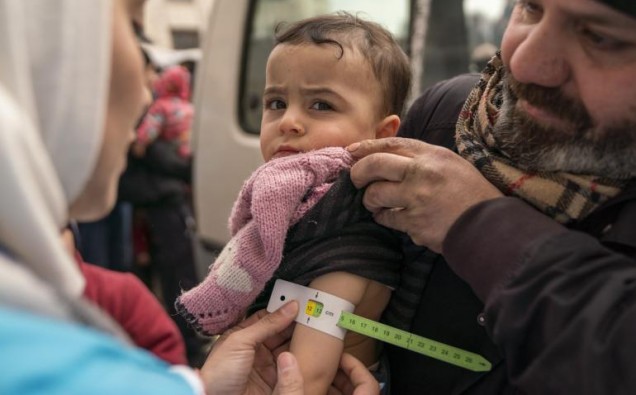Twelve years of conflict, and the recent deadly earthquakes, have left millions of children in Syria at heightened risk of malnutrition, UNICEF warned today.
As the conflict in Syria enters its 13th year on 15 March, hostilities continue unabated in several parts of the country, particularly in the northwest. Grave violations of children’s rights persist. Since the beginning of the conflict, close to 13,000 children in Syria have been killed or injured, according to UN data. Children continue to live in fear of attacks, displacement and malnutrition levels are on the rise.
According to estimates, more than 609,900 children, under the age of five, are stunted in Syria. Stunting results from chronic undernutrition and causes irreversible physical and mental damage to children. This impacts their capacity to learn, their productivity and earnings later in adulthood.
Acute malnutrition among children is also on the rise. The number of 6-59-month-old children suffering from severe acute malnutrition increased by 48 per cent from 2021 to 2022. When children suffer from acute malnutrition, their immune system weakens, and they are eleven times more likely to die than well-nourished children.
Soaring prices and insufficient income mean millions of families are struggling to make ends meet, amid an unparalleled economic crisis. Nearly 90 per cent of people in Syria live in poverty. This impacts children’s diets and nutrition status adversely.
In 2023, prior to the deadly earthquakes that struck Syria on 6 February 2023, more than 3.75 million children required nutritional assistance across the country, while nearly 7 million children countrywide required urgent humanitarian assistance.
“The children of Syria cannot wait any longer. After years of conflict, and two catastrophic earthquakes, the futures of millions of children hang by a thread,” said UNICEF Regional Director for the Middle East and North Africa Adele Khodr. “It is our collective responsibility to reaffirm to children that their future is our priority too.”
The earthquakes destroyed families’ houses and left many children afraid to return home as aftershocks continued. Many families are now displaced and living in cramped conditions in temporary shelters and camps.
Prior to the earthquakes, 6.81 million children in Syria needed basic health services. Half of the primary healthcare system was not functioning forcing many families to either delay medical care or take long trips if they could afford it. It is estimated that only 20,000 physicians remain in Syria. The recent cholera outbreak and the impact of the quakes are putting additional pressure on the already over-burdened public health services and healthcare delivery in the country. It is anticipated to further worsen access to essential health and nutrition services in 2023.
“We must respond to the needs of children wherever they are across Syria and support the systems underpinning the essential services they so desperately need,” said Khodr.
Across Syria, while investing in early detection of malnutrition, UNICEF works with partners to deliver and scale up lifesaving treatment services for children suffering from severe acute malnutrition. Preventive nutrition services including micronutrient supplements, growth monitoring and counselling, and support on breastfeeding and age-appropriate complementary feeding are also being delivered. UNICEF also provides essential health services and supplies, access to clean water and good sanitation to give more children a chance to survive.
Even before the earthquakes, UNICEF’s Humanitarian Action for Children 2023 appeal in Syria was significantly underfunded, with only a fraction of the US$ 328.5 million secured. With the added strain of the earthquakes, the situation has become even more urgent. $172.7 million is required to provide for 5.4 million people (including 2.6 million children) impacted by the earthquake immediate life-saving assistance in Syria.

















